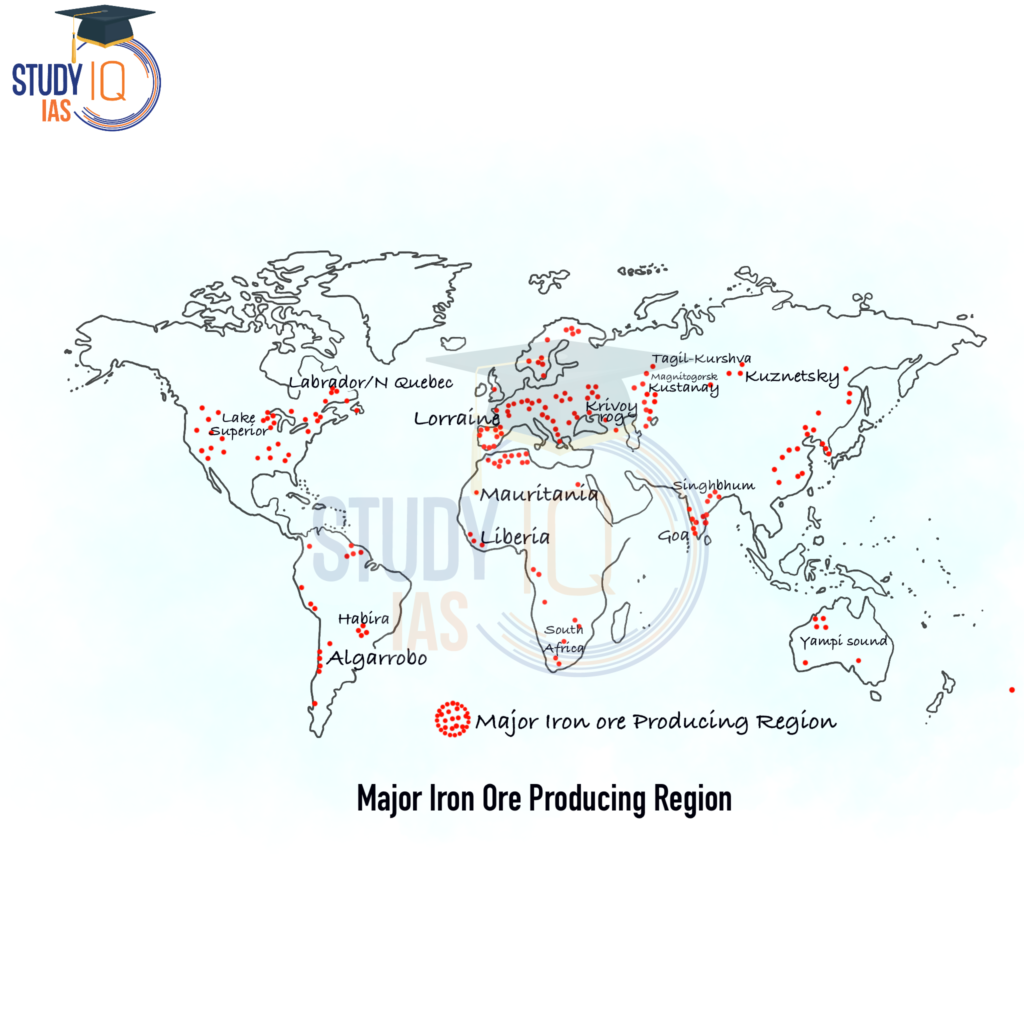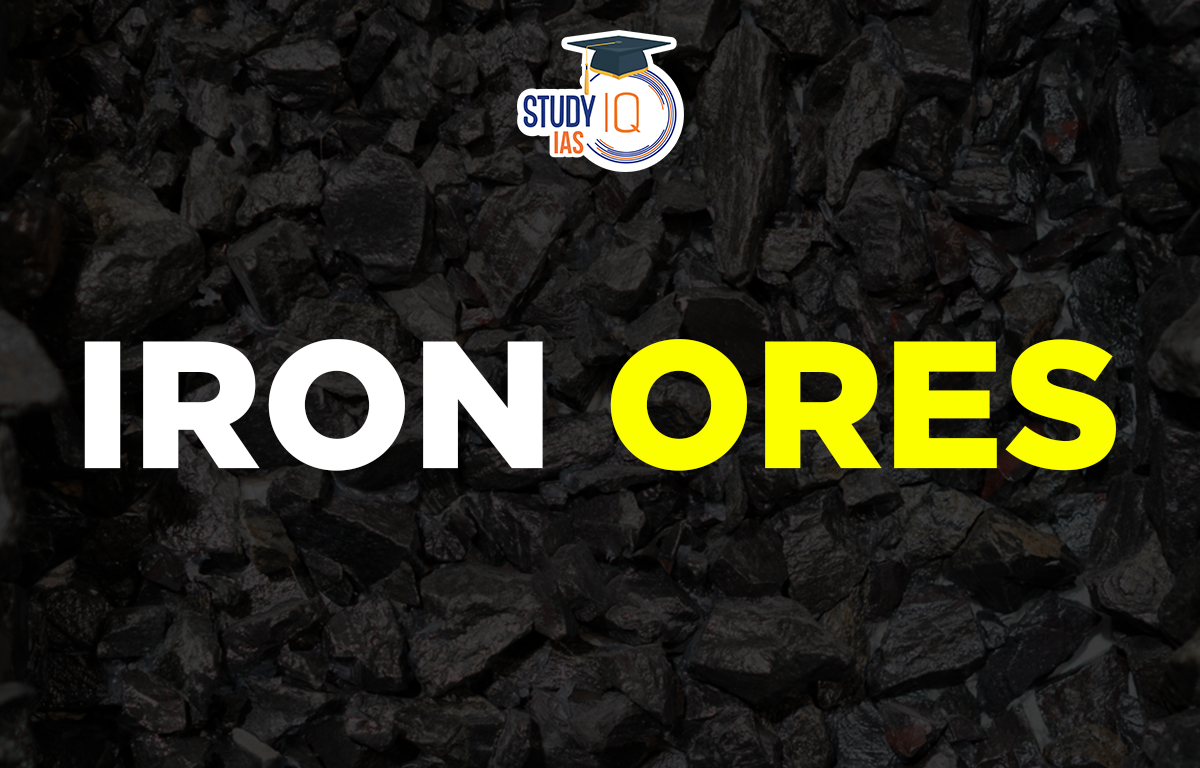Table of Contents
Tata Steel Ltd. has operationalised an all-woman shift (India’s first) at its Noamundi Iron Mine reinforcing its commitment to women’s empowerment.
| Noamundi Mine |
|
Iron Ore
Iron ore is the most important metallic ore. It is known as the backbone of modern civilization. Many industries depend on iron, and hence it is also known as the fundamentals of all industries.
Iron Ore is a naturally occurring solid material from which valuable minerals are extracted for commercial use. Iron ores are rocks and minerals that can be economically extracted to produce metallic iron. They are generally rich in iron oxides. They come in various colours such as dark grey, bright yellow, rusty red, deep purple, etc.
Iron Ore Types
- Magnetite (FE3O4): This is a high-quality ore with about 70% iron. It’s black and magnetic.
- Haematite (FE2O3): This reddish ore has 60-70% iron.
- Limonite: This yellowish ore contains 40-60% iron.
- Siderite: This ore has less than 40% iron and many impurities, making it often not worth mining.
| Facts about Iron Ores |
|
Iron Ore Distribution Map
Map showing the location of Iron Ore Mines in India. Iron Ore mines are found in different regions of India.
Iron Ore Distribution in India
India is projected to remain a leading global iron ore producer, with production levels between 180 to 200 million tonnes. Important states like Odisha, Chhattisgarh, Karnataka, and Jharkhand will continue to drive production, with Odisha contributing over half of the total. Hematite remains the dominant type of iron ore, with magnetite also mined in the south.
Investments in mining infrastructure and technology are expected to boost efficiency and sustainability, supported by government initiatives. Future trends indicate that government policies, such as the National Mineral Policy, will support higher domestic steel production and iron ore output.
- India’s Iron Ore:
- Main types: Hematite and Magnetite.
- Most mines are near coal fields in the northeastern plateau region.
- states: Odisha, Jharkhand, Chhattisgarh, Karnataka, Goa, Telangana, Andhra Pradesh, Tamil Nadu (95% of reserves).
- Odisha:
- Iron ore in Sundergarh, Mayurbhanj, and Jhar hill ranges.
- Jharkhand:
- Oldest mines and many iron and steel plants.
- Important mines: Noamundi and Gua in Poorbi and Pashchimi Singhbhum districts.
- Extends to Durg, Dantewara, and Bailadila.
- Karnataka:
- Iron ore in Sandur-Hospet area (Ballari district), Baba Budan hills, Kudremukh area (Chikkamagaluru district), and parts of Shivamogga, Chitradurg, and Tumakuru districts.
- Other Locations:
- Maharashtra: Chandrapur, Bhandara, and Ratnagiri districts.
- Telangana: Karimnagar and Warangal districts.
- Andhra Pradesh: Kurnool, Cuddapah, and Anantapur districts.
- Tamil Nadu: Salem and Nilgiris districts.
- Goa: Major producer of iron ore.
Top Iron Mines of India
- Bailadila Mines – Chhattisgarh
- Balda Mines – Odisha
- Joda Mines – Odisha
- Noamudi Mine – Jharkhand
| Significant Iron Ore Reserves Discovered in Rajasthan’s Karauli District |
|
Iron Ore Distribution in World
Iron ore is produced in approximately 60 countries worldwide. Iron ore is primarily produced in China, Brazil, Australia, India, Russia, Ukraine, the United States, South Africa, Canada, Sweden, etc. Australia is the world’s largest producer, followed by Brazil and China.

| Country | Regions |
| Australia | Western Australia, Iron knob in South Australia |
| Brazil | Minas Gerais |
| China | Manchurian deposits at Anshan, Yangtze valley, Hopei |
| USA | Lake Superior region, Adirondacks, Alabama, Nevada, California. |
| Canada | Labrador, Quebec, British Columbia. |
| France | Lorraine, Normandy |
| India | Orissa, Jharkhand |
| South Africa | Postmasburg, Thabazimbi |
| Peru | Nazca Marcona |
Iron Ore Uses
Iron ore is an important raw material for the production of steel, which is used in various industries for various purposes. Some of the main uses of iron ore include:
- Steel Production: Iron ore is the main ingredient in the production of steel, which is used in construction, transportation, machinery, and various other industries.
- Infrastructure Development: Steel is a main component in the construction of buildings, bridges, roads, and other infrastructure, making iron ore a crucial resource for infrastructure development.
- Automotive Industry: Steel is a main component in the production of cars and other vehicles, making iron ore an important raw material for the automotive industry.
- Energy Production: Iron ore is used in the production of iron and steel, which is used in power plants and other energy-generating facilities to produce energy.
- Machinery and Equipment: Steel is used in the production of a vast range of machinery and equipment, including agricultural equipment, mining equipment, and construction equipment, making iron ore an important resource for these industries.
- Household Goods: Steel is used in the production of various household goods, including appliances, cookware, and furniture, making iron ore a crucial resource for these industries.
Iron Ore UPSC
The majority of iron ore is used to produce iron, which is then used to produce steel. Steel production accounts for 98% of all iron ore mined today. Staples, automobiles, steel beams used in building construction, and just about anything else that requires iron and steel fall into this category. Industry, construction, all modes of transportation, utensils and household items, electronic devices, and so on.
There are approximately 9,602 million tonnes of recoverable hematite reserves and 3,408 million tonnes of recoverable magnetite reserves of iron ore in India. Chhattisgarh, Madhya Pradesh, Karnataka, Jharkhand, Odisha, Goa, Maharashtra, Andhra Pradesh, Kerala, Rajasthan, and Tamil Nadu are the top iron ore producers in India. This article will explain Iron Ore, which will help you prepare for the UPSC Civil Service Exam in Geography.
| Related Articles | |
| Cobalt Ore | Manganese Ore |
| Copper Ore | Aluminium Ore |
| Nickel Ore | Chromium Ore |


 Vizhinjam International Seaport Project,...
Vizhinjam International Seaport Project,...
 Tsunami Zones of India, Causes and Subdu...
Tsunami Zones of India, Causes and Subdu...
 Places in News for UPSC 2025 for Prelims...
Places in News for UPSC 2025 for Prelims...





















